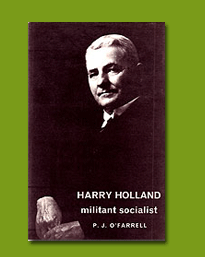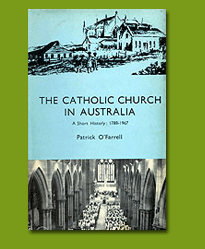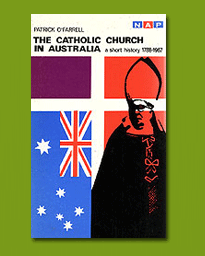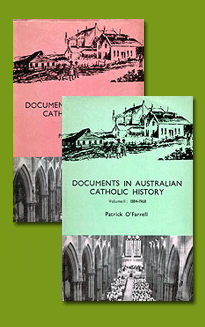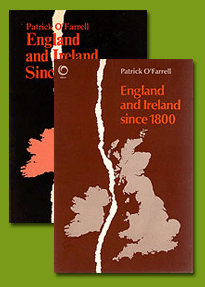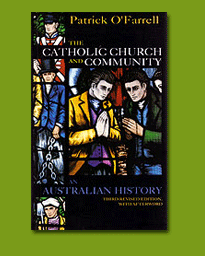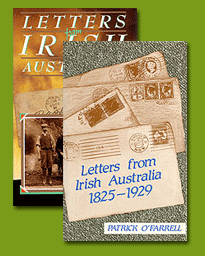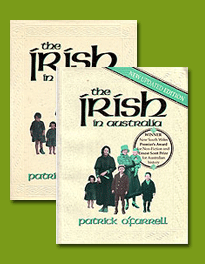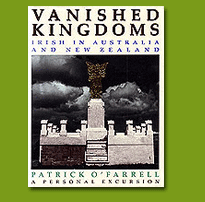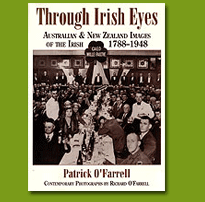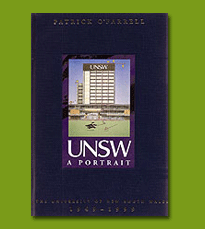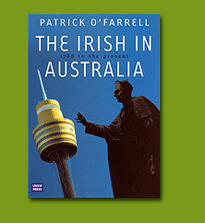BOOKS
Harry Holland: Militant Socialist. Canberra: Australian National University Press, 1964.
This book is a political biography of Henry Edmund Holland, who led the New Zealand Labour Party until his death, in 1933, two years before the Party came to power for the first time. In this finely objective and sympathetic interpretation of Holland's political career – which was his whole life – Dr O'Farrell has presented the interplay of politics, personality, and history in Australia and New Zealand in the early twentieth century, allowing the man to emerge in all his complexity.
Holland, with little formal education, sought, as a doctrinaire socialist, to transform the entire existing social order. Yet he commanded the regard of men as diverse as his colleagues Peter Fraser and Walter Nash (later to be Labour Prime Ministers), Sir Francis Bell (Attorney General in the Reform government of W.F. Massey), and Sir Robert Stout, who in 1913 had sentenced Holland to imprisonment; and the virulence of his opponents' attacks is a measure of their respect for him. At one stage he advocated violence as a means of achieving social revolution, 'whether it be a stern battle on the industrial field where men starve while they fight, or on a sterner battle field where rifles crack and machine guns rattle and shot screams and red blood flows – the victory will be with the Working Class'. Later, in the midst of economic depression, he was prepared to support his political opponents if this would relieve the 'awful distress' that existed. The 'collapse of capitalism' lost its attraction as he came to know what it meant in terms of human anguish.
It may fairly be said that Holland the politician, the Militant Socialist, failed; but Holland, the frail man, austere, reserved, and formidable, dedicated to the service of the people, the man of tremendous compassion, has succeeded far beyond the ephemera of politics.
The Catholic Church in Australia. A Short History 1788-1967. Melbourne: Thomas Nelson, 1968.
Patrick O'Farrell's purpose is to give a historical survey of the Catholic Church in Australia from its beginnings until the present day. For the first thirty years after the planting of Catholicism in Australia the predominantly Irish Catholic population was largely priestless and persecuted. Almost incredibly it survived. After this period some of the key personalities involved in this history were such men as Fr Therry and Archbishop Ullathorne, followed by Archbishop Polding with his 'Benedictine dream'. By the middle of the nineteenth century Australian Catholics no longer had to fight so ardently for religious rights; the battles became political and largely cut across religious divisions and the issues were liberalism, radicalism and authority. Within a decade or so interest switched to the problem of education.
Other issues in the nineteenth century concerned relations between Catholics and the state, and strife between English and Irish factions among Australian Catholics. Cardinal Moran therefore devoted himself partly to establishing and maintaining external harmony and internal unity. In the twentieth century Dr Mannix, as Archbishop of Melbourne from 1912 to 1962, was a rigorous pursuer of principle and the author shows how his period of office was one of 'confrontation, challenge, conflict'. A final chapter discusses the problems of identity and politics from 1925 until the present; this has been a time of considerable political upheaval in the Church's relations with the Labor Party, and more recently of greatly increased lay involvement in Catholic life.
As a true historian Dr O'Farrell not only gives facts but draws out their significance and puts them into perspective. The way in which he relates Australia's Catholic to the rest of world history is particularly striking. The result is what Professor Max Charlesworth of Melbourne University describes as 'a small masterpiece'
To download a review for this book, please click here.
The Catholic Church in Australia. A Short History 1788-1967. 2nd edition. London: Geoffrey Chapman, 1969
To download a review for this book please click here.
Ed.,with Deirdre O'Farrell. Documents in Australian Catholic History. Vol. I, 1788-1884. Vol.II, 1884-1968. London: Geoffrey Chapman, 1969.
This is the companion volume to the author's The Catholic Church in Australia. A Short History: 1788-1967. The purpose of this collection of documents is to make available to both the general reader and the specialist an important part of religious history.
This is the companion volume to the author's The Catholic Church in Australia. A Short History: 1788-1967. The purpose of this collection of documents is to make available to both the general reader and the specialist an important part of religious history.
This collection is arranged chronologically by sections and each section is divided thematically. We are thus enabled to see what may be called the Church's public face as well as her internal life.Externally there are the issues of relations with the government, of education, social questions, politics and sectarianism. Within the Church, the recurrent problems concern organization and structure, the priesthood, the laity, religious practice and so on. As the author says in his introduction, 'the original historical sources, alive with the atmosphere of their own time, will always retain a flavour and excitement uniquely their own'.
Dr O'Farrell's book is particularly important in that it is the first published selection of documents relating to the history of the Catholic Church in Australia, and the author has achieved his purpose by drawing from archives not only in Australia but also in Ireland and Rome.
Ireland's English Question. Anglo-Irish Relations 1534-1970. London: B.T. Batsford; New York: Schocken Books. 1971.
This important re-interpretation of Anglo-Irish history seeks to explain why successive British governments have failed to solve the Irish question. Basically the problem has not been political. It has been historical and religious – a question of identity. Secular England opposed religious Ireland – in secular terms. Since the Reformation the two countries have been divided by differing views of reality and attitudes so divergent that what was precious and meaningful to one, was worthless and incomprehensible to the other.
To the Irish, English rule represented destruction, not of their political forms (for they had few), but of their religion and way of life. The Act of Union of 1800 presumed a basic commonality between the two countries, while in reality if embraced a deep and bitter religious division. The Union served British interests well: it diverted attention away from questioning the basis of the relationship between the two countries into questioning the constitutional form which it had taken. Thus arose the Home Rule campaign.
Professor O'Farrell examines the mass movements of the nineteenth century in detail, pointing out that the Catholic hierarchy, jealous of its authority, was always quick to join and control any such movement. O'Connell and Parnell realized that Church support was vital to the success of any reforms. The author's research into the archives of the Irish hierarchy and the Vatican shows how closely and suspiciously the Church regarded any secular political movement. But worse, any attempt by England to bring in legislation was viewed with hostility. Thus national education was seen as an ungodly conspiracy to destroy the Faith: democracy became a devilish device to undermine all rightful authority.
Though intended primarily for the university student, this original and crisply written study provides an excellent introduction for the general reader wishing to understand the Irish or the present problems in Ulster.
England and Ireland Since 1800. London and New York: Oxford University Press, 1975. Reprinted 1979.
This new interpretation of Anglo-Irish relations since 1800 maintains that there are two realities to the situation – of equal validity: one English, the other Irish. The relationship between England and Ireland is seen to have been conducted largely on the level of irreconcilable stereotypes and prejudices. These 'images' have distorted events and rendered practical realities impotent to being about growth or change.
The approach is thematic rather than chronological, and if the stress falls more on the English images than on the Irish it is because they have been the more powerful determinants in the conflict. The very fact, indeed, that Ireland has in the past remained a 'footnote' to English history the author sees as a source of major aggravation. The historical origins of the English images are reviewed, and then examined as they find political expression in the Irish policies of successive British governments. Political, economic, religious, racial, and national characteristics – all the categories in which Anglo-Irish relations have traditionally been explained – are discussed. A final chapter on violence and counter-violence gives the book an added relevance to the contemporary scene.
This account is of a salutary detachment and lucidity at a time when Anglo-Irish relations show little sign of breaking out of their violent and repetitive cycle. A comprehensive bibliography on the Irish question completes the book.
Patrick O'Farrell was Professor of History at the University of New South Wales, Australia. In 1965-6 and again in 1972-3 he was visiting Professor of History at University College, Dublin, and in 1972-3 at Trinity College, Dublin as well. He is also the author of Ireland's English Question: Anglo-Irish Relations 1534-1970. (Batsford, 1971).
The Catholic Church and Community in Australia: A History. Revised 2nd edition. Melbourne: Thomas Nelson, 1977.
The Catholic Church and Community. An Australian History. Kensington: University of New South Wales Press, 1985. Revised 3rd edition, 1992.
Letters from Irish Australia 1825-1929. Kensington: University of New South Wales Press with Belfast: Ulster Historical Foundation, 1985. Paperback, 1987.
Reading other people's mail, as this books enables the reader to do – with sensitive and incisive commentary and linkage designed to focus and illuminate the material – is to enter the Irish migrant experience with an intimacy whose intensity is particular human and moving. These letters, ranging from those of convicts writing to their wives in the 1820s, through accounts of the voyage out, and pioneering life in mid-century, through love letters, to stories of success and family saga (1883-1929) which ends the book, being their writers alive.
The immigrant Irish, distinctive, independent and colourful, have had a profound and sometimes spectacular impact on the history and character of Australia, but this book goes beyond the sometimes superficial and public manifestations of Irishness in Australia. It shows through the lives of the ordinary Irish – Anglo-Irish, Ulster Protestant Irish, and Catholics from both South and North – the extraordinary complexity and diversity of the Irish influx, and the way it interacted, at the ordinary day-to-day level, with its new Australian environment.
To download a book review by David Fitzpatrick, please click here
The Irish in Australia. Kensington: University of New South Wales Press, 1987. Reprinted 1987, 1988. Revised edition, 1993. American Edition, Indiana: University of Notre Dame Press, 1988.
The names of the Irish-born, high and low, peppered the manifests of the first and second fleets in 1788, by 1791 the direct shipping link with Ireland had begun. While some these Irish were protestants, some free settlers, crew, guards and officers), and some rich or middling prosperous, most were poor, catholic and convicts. They were the beginning of a central, colourful and profoundly influential element in Australia's evolution into a nation different and separate from Britain.
Commencing with Irish convicts, feared and despised – 'nearly as wild themselves as the cattle' – following free Irish immigrants and settlers into the often hostile texture of colonial life, they came to see themselves as patriotic Australians, integrating into all levels and facets of national life and character, many occupying the highest positions in the land in government, law and commerce.
Cutting across the barriers of class, religion and state of origin, Patrick O'Farrell, doyen of Irish-Australian historians, has looked past the Irish clich�s and presented a fascinating and complex picture not only of the big names such as the contrasting heroes of Mannix and Ned Kelly, but also the wives, sweethearts and children, not only the important and influential like Sir Gavan Duffy and Sir Redmond Barry, but also the nursemaids, labourers, farmers and shopkeepers.
Written with pace and authority, the book argues that the Irish were a dynamic factor in our history, a constant galvanizing force; and that the Australian Irish can be properly understood only in their real complexity, Catholic, but also Ulster Protestant and Anglo-Irish.
To download a book review by Tom Boland, please click here
To download another review, please click here
Vanished Kingdoms. Irish in Australia and New Zealand. A Personal Excursion. Contemporary photographs by Richard O'Farrell. Kensington, UNSW Press, 1990.
To download a review written by Michael L'Estrange, please click here
Through Irish Eyes. Australian and New Zealand Images of the Irish 1788-1948. Richmond, Victoria: Aurora Books, David Lovell Publishing, 1994.
"This book is a meditation", says Patrick O'Farrell. It is a meditation on the Irish – those great emigrants and immigrants, travelers and pioneers. It looks back to those days when so many of the Irish left their homeland to journey to the other side of the world.
This book is a commemoration, and a celebration, of a culture now gone, but one which, for all its deficiencies, had real worth, meaning and coherence. It is a story told impressionistically, through innumerable images of the past; the fruit of over more than a quarter of a century orf research. It is an extraordinary collection of photographs, posters, cartoons and ephemera. It will amaze and delight."
The origins of this book go back to the 1970s when I was given a small collection of photographs relating to Irish Australia: they came via the late Tom Mannion, then secretary of the Irish National Association. Since then I have developed that collection as a personal hobby, a sideline to my major Irish research interests. In 20 years it has grown to over 1200 items."
UNSW: A Portrait. The University of New South Wales 1949-1999. Kensington: UNSW Press, 1999.
The University of New South Wales, from its gestation in the Sydney Technical College and it controversial beginnings in 1949, has grown into a diverse, innovating institution, now the largest university in Australia – with, in 1999, a student population of 30,000 and staff of 5000. Since its foundation it has been a leading player in the redefining of traditional notions of university life and character in Australia, maintaining its contributions top public life and its continuing focus on the incorporation of change.
UNSW A Portrait sets out to capture the spirit and achievement of these first fifty years. It is told, not as a dull chronicle, but in a narrative woven through with the experiences of its participants, past and present – from chancellors and vice-chancellors, to former students, academics and administrators. With the immediacy and candour of oral history, their recollections and opinions have been threaded into a richly textured story that conveys the far-reaching activities and aspirations of the university and a sense of the life lived there during that time – a picture further evoked in over 160 photographs, selected from University Archives.
An unconventional approach perhaps, but one well-suited to the lively and unorthodox nature of its subject. One, too, that is informed by the personal experience and sharply humorous insight of the author, who, having lived and worked in the university himself for forty of its fifty years, has been a keen, ironic observer of its foibles and its strengths, and an admirer of its alert, enterprising, individualistic spirit. In all the Professor O'Farrell's Portrait exemplifies the tenor of the first fifty years of bustling life and rapid progress in UNSW – both as a mirror and expression of the university that commissioned it.
UNSW A Portrait is Professor O'Farrell's eleventh book. His historical expertise and reputation have been wide and various....
The Irish in Australia. 1788 to the Present. Kensington: UNSW Press, 2000. American edition, University of Notre Dame Press. Irish edition, Cork University Press.
The names of the Irish-born, high and low, peppered the manifests of the first and second fleets in 1788, by 1791 the direct shipping link with Ireland had begun. While some these Irish were protestants, some free settlers, crew, guards and officers), and some rich or middling prosperous, most were poor, catholic and convicts. They were the beginning of a central, colourful and profoundly influential element in Australia's evolution into a nation different and separate from Britain.
Commencing with Irish convicts, feared and despised – 'nearly as wild themselves as the cattle' – following free Irish immigrants and settlers into the often hostile texture of colonial life, they came to see themselves as patriotic Australians, integrating into all levels and facets of national life and character, many occupying the highest positions in the land in government, law and commerce.
Cutting across the barriers of class, religion and state of origin, Patrick O'Farrell, doyen of Irish-Australian historians, has looked past the Irish clich�s and presented a fascinating and complex picture not only of the big names such as the contrasting heroes of Mannix and Ned Kelly, but also the wives, sweethearts and children, not only the important and influential like Sir Gavan Duffy and Sir Redmond Barry, but also the nursemaids, labourers, farmers and shopkeepers.
Written with pace and authority, the book argues that the Irish were a dynamic factor in our history, a constant galvanizing force; and that the Australian Irish can be properly understood only in their real complexity, Catholic, but also Ulster Protestant and Anglo-Irish.
© Patrick O'Farrell 2024 | silvertrees web development
